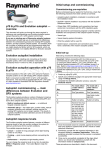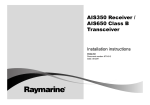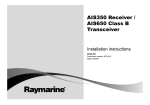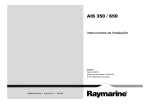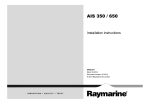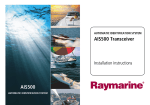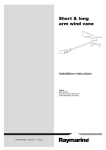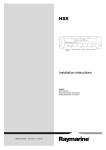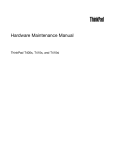Download Raymarine 150 Installation manual
Transcript
GA150 antenna Installation instructions English Date: 05-2014 Document number: 87230-1-EN © 2014 Raymarine UK Limited Trademark and patents notice Autohelm, hsb2, RayTech Navigator, Sail Pilot, SeaTalk, SeaTalkNG, SeaTalkHS and Sportpilot are registered trademarks of Raymarine UK Limited. RayTalk, Seahawk, Smartpilot, Pathfinder and Raymarine are registered trademarks of Raymarine Holdings Limited. FLIR is a registered trademark of FLIR Systems, Inc. and/or its subsidiaries. All other trademarks, trade names, or company names referenced herein are used for identification only and are the property of their respective owners. This product is protected by patents, design patents, patents pending, or design patents pending. Fair Use Statement You may print no more than three copies of this manual for your own use. You may not make any further copies or distribute or use the manual in any other way including without limitation exploiting the manual commercially or giving or selling copies to third parties. Software updates Check the website www.raymarine.com for the latest software releases for your product. Product handbooks The latest versions of all English and translated handbooks are available to download in PDF format from the website www.raymarine.com. Please check the website to ensure you have the latest handbooks. Copyright ©2014 Raymarine UK Ltd. All rights reserved. ENGLISH Document number: 87230-1 Date: 05-2014 Contents Chapter 1 Important information........................ 7 Certified Installation ................................................... 7 Water ingress ............................................................ 7 Disclaimer ................................................................. 7 EMC installation guidelines ........................................ 7 Suppression ferrites ................................................... 7 Connections to other equipment ................................. 7 Declaration of conformity............................................ 7 Product disposal ........................................................ 7 Warranty registration.................................................. 8 IMO and SOLAS........................................................ 8 Technical accuracy .................................................... 8 Chapter 2 Document and product information........................................................... 9 2.1 Document information .......................................... 10 2.2 GA150 Parts supplied........................................... 10 2.3 GA150 product overview ...................................... 11 Chapter 3 Planning the installation ................... 13 3.1 Installation checklist ............................................. 14 3.2 GA150 MFD compatibility ..................................... 14 3.3 Tools required ...................................................... 15 3.4 Warnings and cautions ......................................... 15 3.5 Antenna location requirements.............................. 16 3.6 Product dimensions.............................................. 16 Chapter 4 Cables and connections.................... 17 4.1 General cabling guidance ..................................... 18 4.2 GA150 connection................................................ 18 Chapter 5 Mounting............................................. 19 5.1 Fitting the antenna ............................................... 20 5.2 Surface mounting................................................. 20 5.3 Pole mounting...................................................... 21 Chapter 6 System checks and troubleshooting ................................................... 23 6.1 Further information............................................... 24 6.2 Troubleshooting ................................................... 25 Chapter 7 Maintenance ....................................... 27 7.1 Routine checks .................................................... 28 7.2 Unit cleaning instructions ...................................... 28 Chapter 8 Technical support .............................. 29 8.1 Raymarine customer support ................................ 30 Chapter 9 Technical specification...................... 31 9.1 Technical specification.......................................... 32 5 6 GA150 Chapter 1: Important information Certified Installation Raymarine recommends certified installation by a Raymarine approved installer. A certified installation qualifies for enhanced product warranty benefits. Contact your Raymarine dealer for further details, and refer to the separate warranty document packed with your product. Warning: Product installation and operation This product must be installed and operated in accordance with the instructions provided. Failure to do so could result in personal injury, damage to your vessel and/or poor product performance. Warning: Potential ignition source This product is NOT approved for use in hazardous/flammable atmospheres. Do NOT install in a hazardous/flammable atmosphere (such as in an engine room or near fuel tanks). Warning: Switch off power supply Ensure the vessel’s power supply is switched OFF before starting to install this product. Do NOT connect or disconnect equipment with the power switched on, unless instructed in this document. Note: In areas of extreme EMC interference, some slight interference may be noticed on the product. Where this occurs the product and the source of the interference should be separated by a greater distance. For optimum EMC performance we recommend that wherever possible: • Raymarine equipment and cables connected to it are: – At least 1 m (3 ft) from any equipment transmitting or cables carrying radio signals e.g. VHF radios, cables and antennas. In the case of SSB radios, the distance should be increased to 7 ft (2 m). – More than 2 m (7 ft) from the path of a radar beam. A radar beam can normally be assumed to spread 20 degrees above and below the radiating element. • The product is supplied from a separate battery from that used for engine start. This is important to prevent erratic behavior and data loss which can occur if the engine start does not have a separate battery. • Raymarine specified cables are used. • Cables are not cut or extended, unless doing so is detailed in the installation manual. Note: Where constraints on the installation prevent any of the above recommendations, always ensure the maximum possible separation between different items of electrical equipment, to provide the best conditions for EMC performance throughout the installation Suppression ferrites Caution: Service and maintenance This product contains no user serviceable components. Please refer all maintenance and repair to authorized Raymarine dealers. Unauthorized repair may affect your warranty. Raymarine cables may be fitted with suppression ferrites. These are important for correct EMC performance. If a ferrite has to be removed for any purpose (e.g. installation or maintenance), it must be replaced in the original position before the product is used. Use only ferrites of the correct type, supplied by Raymarine authorized dealers. Water ingress Water ingress disclaimer Although the waterproof rating capacity of this product meets the stated IPX standard (refer to the product’s Technical Specification), water intrusion and subsequent equipment failure may occur if the product is subjected to commercial high-pressure washing. Raymarine will not warrant products subjected to high-pressure washing. Disclaimer Raymarine does not warrant that this product is error-free or that it is compatible with products manufactured by any person or entity other than Raymarine. Where an installation requires multiple ferrites to be added to a cable, additional cable clips should be used to prevent stress on the connectors due to the extra weight of the cable. Connections to other equipment Requirement for ferrites on non-Raymarine cables If your Raymarine equipment is to be connected to other equipment using a cable not supplied by Raymarine, a suppression ferrite MUST always be attached to the cable near the Raymarine unit. Declaration of conformity Raymarine UK Ltd. declares that this product is compliant with the essential requirements of R&TTE directive 1999/5/EC. Raymarine is not responsible for damages or injuries caused by your use or inability to use the product, by the interaction of the product with products manufactured by others, or by errors in information utilized by the product supplied by third parties. The original Declaration of Conformity certificate may be viewed on the relevant product page at www.raymarine.com. EMC installation guidelines Product disposal Raymarine equipment and accessories conform to the appropriate Electromagnetic Compatibility (EMC) regulations, to minimize electromagnetic interference between equipment and minimize the effect such interference could have on the performance of your system Dispose of this product in accordance with the WEEE Directive. Correct installation is required to ensure that EMC performance is not compromised. Important information The Waste Electrical and Electronic Equipment (WEEE) Directive requires the recycling of waste electrical and electronic equipment. Whilst the WEEE Directive does not apply to some Raymarine products, we support its policy and ask you to be aware of how to dispose of this product. 7 Warranty registration To register your Raymarine product ownership, please visit www.raymarine.com and register online. It is important that you register your product to receive full warranty benefits. Your unit package includes a bar code label indicating the serial number of the unit. You will need this serial number when registering your product online. You should retain the label for future reference. IMO and SOLAS The equipment described within this document is intended for use on leisure marine boats and workboats NOT covered by International Maritime Organization (IMO) and Safety of Life at Sea (SOLAS) Carriage Regulations. Technical accuracy To the best of our knowledge, the information in this document was correct at the time it was produced. However, Raymarine cannot accept liability for any inaccuracies or omissions it may contain. In addition, our policy of continuous product improvement may change specifications without notice. As a result, Raymarine cannot accept liability for any differences between the product and this document. Please check the Raymarine website (www.raymarine.com) to ensure you have the most up-to-date version(s) of the documentation for your product. 8 GA150 Chapter 2: Document and product information Chapter contents • 2.1 Document information on page 10 • 2.2 GA150 Parts supplied on page 10 • 2.3 GA150 product overview on page 11 Document and product information 9 2.1 Document information 2.2 GA150 Parts supplied This document contains important information related to the installation of your Raymarine product. The parts supplied with your GA150 GNSS (GPS / GLONASS) antenna are shown below. The document includes information to help you: • plan your installation and ensure you have all the necessary equipment; • install and connect your product as part of a wider system of connected marine electronics; 1 4 2 5 3 6 7 • troubleshoot problems and obtain technical support if required. This and other Raymarine product documents are available to download in PDF format from www.raymarine.com. D13075-1 Applicable products This document is applicable to the following products: 1. GA150 antenna (The antenna is supplied with a fitted 10 m (33 ft.) cable for connection to your MFD.) Part number Name Description 2. GA150 mounting gasket A80288 GA150 GNSS (GPS / GLONASS) antenna 3. Pole mount adaptor 4. 2 x Thumbs nuts 5. 2 x Studs 6. 2 x screws Document illustrations 7. Document pack Your product may differ slightly from that shown in the illustrations in this document, depending on product variant and date of manufacture. All images are provided for illustration purposes only. Product documentation The following documentation is applicable to your product: Description Part number GA150 Installation instructions Installation of a GA150 antenna and connection to a compatible MFD. 87230 / 88038 GA150 Surface mount template Mounting diagram for surface mounting a GA150. 87224 10 GA150 2.3 GA150 product overview The GA150 is an external antenna capable of improving the reception of a Multifunction display’s (MFD’s) internal Global Navigation Satellite System (GNSS) receiver. D13078-1 The GA150 has the following features: • 10 m (33 ft.) fitted cable. • Low power consumption. • Surface or pole mountable. Note: When the Beidou GNSS becomes available a GA150 MUST be used in order to obtain reception. Your MFD will also require a software update to enable support of the Beidou system. Document and product information 11 12 GA150 Chapter 3: Planning the installation Chapter contents • 3.1 Installation checklist on page 14 • 3.2 GA150 MFD compatibility on page 14 • 3.3 Tools required on page 15 • 3.4 Warnings and cautions on page 15 • 3.5 Antenna location requirements on page 16 • 3.6 Product dimensions on page 16 Planning the installation 13 3.1 Installation checklist 3.2 GA150 MFD compatibility Installation includes the following activities: The GA150 antenna is compatible with the following Raymarine variant MFDs: Installation Task • a95 / a97 / a98 1 Plan your system. 2 Obtain all required equipment and tools. 3 Site all equipment. Multifunction display software requirements 4 Route all cables. 5 Drill cable and mounting holes. The operation of this product requires that your Raymarine MFD is running LightHouse II software Release 11 or later. 6 Make all connections into equipment. 7 Secure all equipment in place. 8 Power on and test the system. • a125 / a127 / a128 Schematic diagram A schematic diagram is an essential part of planning any installation. It is also useful for any future additions or maintenance of the system. The diagram should include: • Location of all components. • Connectors, cable types, routes and lengths. 14 GA150 3.3 Tools required 3.4 Warnings and cautions Product installation requires the following tools: Item Description Quantity Power drill 1 Pozidrive screwdriver 1 Drill bit of appropriate size* 1 Adhesive tape 1 Important: Before proceeding, ensure that you have read and understood the warnings and cautions provided in the Chapter 1 Important information section of this document. Note: * The appropriate drill bit size is dependent on the thickness and material of the mounting surface. Planning the installation 15 The antenna can be mounted either on a flat horizontal surface or on a suitable pole. • If you intend to surface mount the antenna, ensure you have access to the underside of the mounting surface. • If you intend to pole-mount the antenna, the pole needs to have a 1 inch 14 TPI thread. 95 mm (3.7 in.) 30 mm (1.2 in.) The antenna can be used to improve the reception of your MFD’s built-in GNSS (GPS / GLONASS) receiver. Do NOT connect any other antenna to the MFD’s GA150 connector. 3.6 Product dimensions 32 mm (1.3 in.) 3.5 Antenna location requirements D13077-1 Important: The antenna must be mounted in a location that provides a good direct line of site to the entire sky, around the horizon. Ensure that the selected mounting location is: • Open and clear of any obstructions (such as masts, search lights, or other structures) that could block line-of-sight to the sky. • As low as possible, to keep the antenna as stable as possible. The more stable the antenna, the more effectively it will track satellites and provide stable data. • As far as possible (at least 1 m (3 ft) from other antennae and electronic equipment. Do NOT mount the antenna: • In any area where it could be stepped on or tripped over. • Up a mast. This will cause the antenna to swing and give significant errors in position data. • In the direct path of a radar beam. Antenna Mounting & EME Exposure For optimal radio performance and minimal human exposure to radio frequency electromagnetic energy, make sure the antenna is: • connected to the radio before transmitting • properly mounted • located where it will be away from people • located at least 1.5 metres (5 feet) from the radio’s main unit 16 GA150 Chapter 4: Cables and connections Chapter contents • 4.1 General cabling guidance on page 18 • 4.2 GA150 connection on page 18 Cables and connections 17 4.1 General cabling guidance 4.2 GA150 connection Cable types and length a9x and a12x MFDs include an internal GNSS (GPS / GLONASS) receiver. The GA150 antenna can be used to improve the GNSS (GPS / GLONASS) receiver’s reception. It is important to use cables of the appropriate type and length • Unless otherwise stated use only standard cables of the correct type, supplied by Raymarine. 1 2 • Ensure that any non-Raymarine cables are of the correct quality and gauge. For example, longer power cable runs may require larger wire gauges to minimize voltage drop along the run. Routing cables D13069-1 Cables must be routed correctly, to maximize performance and prolong cable life. • Do NOT bend cables excessively. Wherever possible, ensure a minimum bend diameter of 200 mm (8 in) / minimum bend radius of 100 mm (4 in). 1. GA150 antenna 2. a9x or a12x variant MFD For installation details for your external antenna, refer to the documentation that accompanied the antenna. Note: 200 mm (8 in) • The Beidou GNSS is supported but not currently available. 100 mm (4 in) • Protect all cables from physical damage and exposure to heat. Use trunking or conduit where possible. Do NOT run cables through bilges or doorways, or close to moving or hot objects. • Secure cables in place using tie-wraps or lacing twine. Coil any extra cable and tie it out of the way. • Where a cable passes through an exposed bulkhead or deckhead, use a suitable watertight feed-through. • Do NOT run cables near to engines or fluorescent lights. Always route data cables as far away as possible from: • other equipment and cables, • high current carrying ac and dc power lines, • antennae. Caution: Pulling cables Do NOT use cords or ropes, attached to cable connectors, to pull cables through restricted apertures (e.g. as in bulkheads), as this could cause damage to cables. • A GA150 must be connected in order to receive the Beidou system when it becomes available. • A software update will be required to add support for Beidou once the system is available. Please check with your Raymarine dealer for further details. Antenna cable length The GA150 is supplied with a fitted 10 m (33 ft.) cable. The length of the antenna cable can be extended if required. The antenna cable length can be extended by up to 10 m (33 ft.) giving a total maximum cable length of 20 m (66 ft.) 50 ohm coaxial cable and reliable connectors (offering protection against water ingress) must be used when extending the antenna cable. Note: Extending the cable length by more than the recommended maximum length will result in signal degradation. Connecting an external antenna Follow the steps below to connect the GA150 external antenna to your a9x or a12x variant MFD. 1 2 3 4 Strain relief Ensure adequate strain relief is provided. Protect connectors from strain and ensure they will not pull out under extreme sea conditions. Cable shielding Ensure that all data cables are properly shielded that the cable shielding is intact (e.g. hasn’t been scraped off by being squeezed through a tight area). D13074-1 1. Fully insert the antenna’s cable connector into the GA150 connector on the rear of your display. 2. Turn the locking collar clockwise until TIGHT. 3. Push to protective boot over the connection on the back of the display. 4. Use the supplied cable tie to secure the protective boot over the connection. 18 GA150 Chapter 5: Mounting Chapter contents • 5.1 Fitting the antenna on page 20 • 5.2 Surface mounting on page 20 • 5.3 Pole mounting on page 21 Mounting 19 5.1 Fitting the antenna 5.2 Surface mounting To fit the antenna: 1. Select a suitable location for the antenna as described under Antenna location requirements. 2. Fit your antenna using either the Surface mounting or Pole mounting procedure, as appropriate. 3. Ensuring that cable routing and connection requirements as detailed in the installation instructions for the product that the antenna will be connected to are followed. When surface mounting the antenna, you can route the cable either centrally (Option A) or from the side of the antenna (Option B). 1. Use the template supplied to mark the two 6 mm (0.25 in) mounting holes. • OPTION A: If the cable is going to pass through the mounting surface drill a 19 mm (0.75 in) center hole. • OPTION B: If the cable is to be routed from the side of the antenna (i.e. above the mounting surface), remove the two plastic tabs (1) obstructing the cable channel. If you do not remove these tabs before using the cable channel, you could damage the cable. 2 B 3 2 4 4 Top view Underside view 1 3 D11638-1 A 2. Screw the two mounting studs (2) into the underside of the antenna. 3. Stick the supplied gasket (3) to the mounting surface, ensuring that the holes on the gasket correspond with the drilled holes. 4. Route the cable as follows: • For Option A, feed the cable down through the center hole. • For Option B, route the cable along the cable exit channel. 5. Carefully place the antenna so the mounting studs pass through the holes in the mounting surface. 6. Secure the antenna to the surface using the supplied thumb nuts (4). 20 GA150 5.3 Pole mounting If you want to pole-mount the antenna, obtain a pole of suitable length with a 1 inch 14 TPI thread. A B D13076-1 1. Ensuring that the Antenna location requirements are met, securely attach the pole to a suitable, stable point. 2. Screw the pole mount adaptor fully onto the pole and ensure it is secure on the pole. 3. Route the antenna cable as follows: i. If you want to route the antenna cable directly down from the antenna (option A), feed it through the center of the pole mount adaptor and then down through the pole. ii. If you want to route the antenna cable out of the side of the antenna (option B), remove the two plastic tabs from the cable channel, then feed the cable along the channel. 4. Ensuring you do not trap the cable, place the antenna on the pole mount adaptor so the screw holes align, then secure the antenna with the screws provided. Mounting 21 22 GA150 Chapter 6: System checks and troubleshooting Chapter contents • 6.1 Further information on page 24 • 6.2 Troubleshooting on page 25 System checks and troubleshooting 23 6.1 Further information For detailed operating instructions, refer to the handbook that accompanies your display. 24 GA150 6.2 Troubleshooting The troubleshooting information provides possible causes and corrective action required for common problems associated with marine electronics installations. All Raymarine products are, prior to packing and shipping, subjected to comprehensive test and quality assurance programs. However, if you experience problems with the operation of your product this section will help you to diagnose and correct problems in order to restore normal operation. If after referring to this section you are still having problems with your unit, please contact Raymarine Technical Support for further advice. System checks and troubleshooting 25 GPS troubleshooting Problems with the GPS and their possible causes and solutions are described here. Problem Possible causes Possible solutions “No Fix” GPS status icon is displayed. Geographic location or prevailing conditions preventing satellite fix. Check periodically to see if a fix is obtained in better conditions or another geographic location. GPS connection fault. Ensure that external GPS connections and cabling are correct and fault free. External GPS antenna in poor position. For example: Ensure GPS antenna has a clear view of the sky. • Below decks. • Close proximity to transmitting equipment such as VHF radio. GPS installation problem. Refer to the installation instructions. Note: A GPS Status screen is available within the display. This provides satellite signal strength and other relevant information. 26 GA150 Chapter 7: Maintenance Chapter contents • 7.1 Routine checks on page 28 • 7.2 Unit cleaning instructions on page 28 Maintenance 27 7.1 Routine checks 7.2 Unit cleaning instructions The following periodic checks should be made: The unit does not require regular cleaning. However, if you find it necessary to clean the unit, please follow the steps below: 1. Ensure power is switched off. 2. Wipe unit clean with a damp cloth. 3. If necessary, use a mild detergent solution to remove grease marks. • Examine cables for signs of damage, such as chafing, cuts or nicks. • Check that the cable connectors are firmly attached and that their locking mechanisms are properly engaged. Note: Cable checks should be carried out with the power supply switched off. 28 GA150 Chapter 8: Technical support Chapter contents • 8.1 Raymarine customer support on page 30 Technical support 29 8.1 Raymarine customer support Raymarine provides a comprehensive customer support service. You can contact customer support through the Raymarine website, telephone and e-mail. If you are unable to resolve a problem, please use any of these facilities to obtain additional help. Web support Please visit the customer support area of our website at: www.raymarine.com This contains Frequently Asked Questions, servicing information, e-mail access to the Raymarine Technical Support Department and details of worldwide Raymarine agents. Telephone and e-mail support In the USA: • Tel: +1 603 324 7900 • Toll Free: +1 800 539 5539 • E-mail: [email protected] In the UK, Europe, and the Middle East: • Tel: +44 (0)13 2924 6777 • E-mail: [email protected] In Southeast Asia and Australia: • Tel: +61 (0)29479 4800 • E-mail: [email protected] Product information If you need to request service, please have the following information to hand: • Product name. • Product identity. • Serial number. • Software application version. • System diagrams. You can obtain this product information using the menus within your product. 30 GA150 Chapter 9: Technical specification Chapter contents • 9.1 Technical specification on page 32 Technical specification 31 9.1 Technical specification Physical specification Dimensions • Diameter: 95 mm (3.7 in.) • Height: 30 mm (1.2 in.) • Height (including pole mount adaptor): 62 mm (2.5 in.) Weight • Boxed weight 0.74 Kg (1.6 lbs) • Unboxed weight (including cable): 0.5 Kg (1.1 lbs) Environmental specification Operating temperature 0°C to +55°C (+32°F to +131°F) Storage temperature –30°C to +70°C (-22°F to +158°F) Relative humidity 95% Waterproof rating IPX6 and IPX7 Conformance specification Conformance • EN 60945:2002 • R&TTE Directive 1999/5/EC • Australia and New Zealand: C-Tick, Compliance Level 2 32 GA150 www.ra ym a rin e .c o m


































